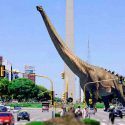In 2018, Apple became the world’s first trillion-dollar company. To this day, there are just five companies in the world worth over a trillion dollars.
To put into perspective just how much one trillion is, a million seconds is around 12 days, a billion seconds is about 32 years, and a trillion seconds is more than all of recorded history, just under 32,000 years. In other words, you could never count that high.
It’s no surprise that there are no individual trillionaires in the world. Becoming a billionaire is difficult enough, and coming up with creative ways to make money is getting harder and harder every day.
Yet, as crazy as it sounds, the person who will be the world’s first trillionaire might be alive today.
It could be Elon Musk, Mark Zuckerberg, or maybe even a random person walking down the street, and you would have no clue whatsoever.
How can one individual make that much money? Simple. Asteroid mining.
In an interview in 2016, Neil deGrasse Tyson revealed the secrets to amassing Scrooge McDuck levels of wealth.
Clip: It is likely that the first trillionaire. Will be the person who exploits the mineral resources on asteroids.
And the man is entirely correct. Asteroid mining may soon switch from science fiction to reality. Turning billionaires into trillionaires.
NASA tracks the locations of thousands of asteroids and Near Earth Objects or NEOs (enn-ee-ohs), some of which are worth trillions of dollars. According to NASA, approximately 14 thousand NEOs come relatively close to Earth at some point during their orbit.
Many of these nearby asteroids contain minerals and materials that hold value on Earth. And there’s a seemingly infinite amount of them out there in space.
The asteroid belt between Mars and Jupiter alone is estimated to contain upwards of two million asteroids larger than one kilometer in diameter and millions of smaller ones.
Right now, mining an absurd amount of resources from asteroids and hauling them back to Earth is too expensive. But once the technology gets more affordable, the individuals who extract these resources will be the first trillionaires of our time.
In 2015, an asteroid code-named 2011 UW-158 whipped past our planet at a distance of 2.4 million km (1.5 million mi), about six times the distance between the Earth and the Moon.
It carries more than 90 million tons of platinum in its core, as well as many other rare and precious materials. Scientists estimate that this one-kilometer-wide (.62 mi) platinum-rich asteroid is worth over 5.4 trillion U.S. dollars.
This single asteroid is worth more than the two most valuable companies on Earth, Apple and Microsoft, combined.
But an even larger opportunity presented itself in 2013. A 30-meter-wide (100 ft) asteroid named 2012-DA14 made a flyby of Earth that was a little too close for comfort. The asteroid came so close that it flew within the ring of geostationary satellites at an altitude of only about 35,000 km (22,000 mi). The distance to the Moon is only 384,000 km (239,000 mi), meaning that 2012-DA14 passed by our planet at a distance 1/11th that of our closest cosmic neighbor.
Shooting past Earth at a whopping speed of 7.8 km/s (4.8 mi per second), if it hit Earth, 2012-DA14 would have caused massive damage. Although it might not seem that large, with a kinetic energy of 3.5 megatons, this asteroid impact would have produced a blast 200 times more powerful than the bomb that was dropped on Hiroshima. That’s more than enough to wipe out an entire city… in an instant.
Thankfully, 2012-DA14 was not on a collision course to Earth. Although just 16 hours before its close call, the Chelyabinsk (chell-yaahhb-insk) Meteor entered Earth’s atmosphere and crashed into the Russian city, seriously injuring over 1000 people.
Even though it was later confirmed that the two asteroids hadn’t influenced each other in any way, it is still crazy to think that two massive asteroids could have potentially hit Earth on the same day.
Unfortunately, the Chelyabinsk meteor had no precious metals, and fragments could only be sold as collector’s items.
But 2012-DA14 was very different. Although its size may not seem spectacular, this 30-meter-wide asteroid could be worth over 20 trillion U.S. dollars.
This single asteroid could fend off starvation and malnutrition worldwide for 27 years. Or it could send every single high school graduate in the United States to college for free… for the next 114 years.
And this is nowhere near the price tag of the most valuable asteroid ever found.
Asteroid 1903 LU is the seventh-largest asteroid found to date. Discovered in 1903 by American astronomer Ramen Smith Dugan, 1903 LU hovers over the Sun in the main asteroid belt between Mars and Jupiter. It’s composed of nickel, iron, cobalt, water, nitrogen, and hydrogen, all of which are incredibly useful resources to industries around the globe.
This asteroid is worth so much that I don’t think we can fully comprehend it.
At 323 km (201 mi) in diameter, asteroid 1903 LU is worth a mind-boggling 15.38 quintillion dollars. I’ll let that sink in for a second.
Do you realize how much you can do with 15 quintillion dollars? Consider this thought experiment to put this massive amount of money into perspective.
One U.S. dollar bill is 16 cm (6.3 in) long. If you were to take 15.38 quintillion dollar bills and lay them out, end to end, you’d have a line of one dollar bills 2.46 x 10 raised to the power of 18 m long. This 15-quintillion-dollar line would stretch from Earth to Alpha Centauri, the closest star system to our Sun. 30 times. Yeah.
Although 1903 LU is worth an inconceivable amount of money, it isn’t the most cost-effective asteroid to mine. Asteroid 1999 j-u3 is one of our best chances at mining an asteroid. Its unique orbit causes it to come within a few million kilometers of Earth every four or five years.
As a result, we can take multiple trips to the asteroid for 10, 20, or 30 years to mine the asteroid for the maximum amount of materials we can bring back to Earth.
Although 1999 j-u3 is estimated to be worth only 83 billion U.S. dollars, it’s one of the most cost-effective asteroids to mine thanks to its location and convenient orbit. This could be our baby step into the asteroid mining industry and pave the way for future explorers and entrepreneurs to push humanity up into space and maybe even jump-start a second space race.
Let’s be honest. That would be awesome.
In 2010, U.S. President Barack Obama announced that a human mission to an asteroid would be a goal to achieve before 2025.
Clip: Obama Speech
It’s currently 2023, and the former president was spot-on with his prediction. NASA is currently working on the Artemis mission, and the second part of that mission, scheduled to launch in May 2024, will see four astronauts travel farther into space than any human ever before.
By 2025, the third mission will see the first woman and person of color set foot on the Moon with the goal of building a base there. Unlike the Apollo missions, our plan with Artemis is not just to visit and explore the Moon. If all three missions are successful, NASA plans to send crewed missions annually so that astronauts can begin establishing a Moon base to serve as a staging point for exploring the rest of our Solar System.
But the challenge with the rest of President Obama’s speech is if we want to build a base on the Moon and eventually colonize Mars, we’ll need to learn how to mine asteroids because it’s much cheaper to mine resources on nearby asteroids than to try shipping the already limited resources we have on our planet to outer space.
Now, we haven’t really talked about one crucial resource: water. While water may not be worth trillions of dollars… yet. It is the most important resource required to keep a space colony alive. Without finding a source of water up there, there’s no way we can explore space.
Water is also essential because it can be broken down into hydrogen and oxygen, which can be used to create rocket fuel. If we can produce rocket fuel on the Moon, we can send lighter rockets into space. Ones that can refuel during their mission, allowing us to take trips from our Moon base to different parts of deep space without having to return to Earth.
With all the essential resources and the incredible wealth stored in asteroids, why haven’t we started mining them yet? Well, like I said earlier, it’s way too expensive, and no one is ready to take on those expenses yet.
To understand the potential cost implications, consider NASA’s OSIRIS-REx mission. ORISIS-REx is the first U.S. mission to collect a sample from an asteroid. Right now, it’s on its way back from asteroid Bennu with a sample that weighs just around 400 grams to 1 kilogram (14 oz and 2.2 lbs).
Although it’s only retrieving a relatively small sample, this mission cost NASA around 1.1 billion dollars and took seven years from its launch in 2016 to its return, scheduled to happen in 2023. Now imagine how long it’d take and how much money it would cost for us to mine an asteroid as big as 1903 LU.
Still, because the biggest challenge with asteroid mining is the funding and not necessarily the technological limitation, it’s not crazy to think that eventually, someone or some people with more than enough disposable income will invest in this sector and usher the world into a new era of wealth, space exploration, and abundance of resources.
We can only hope that those who do this will use the resources to advance our species and not for their own selfish gain.



















